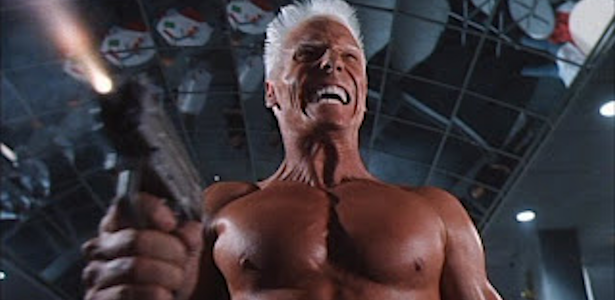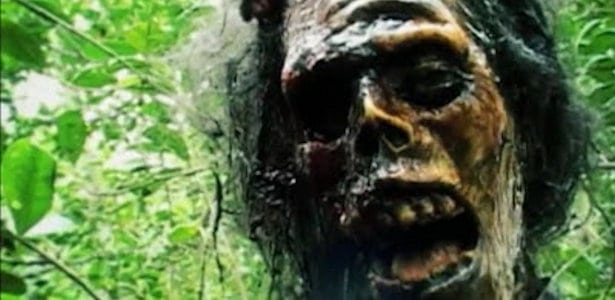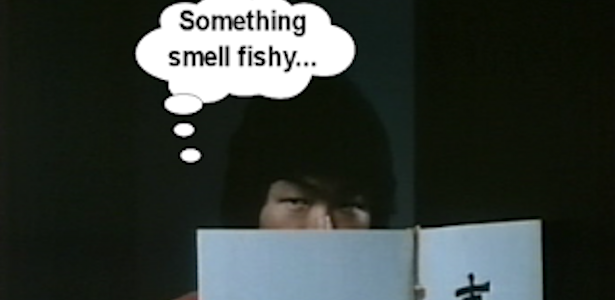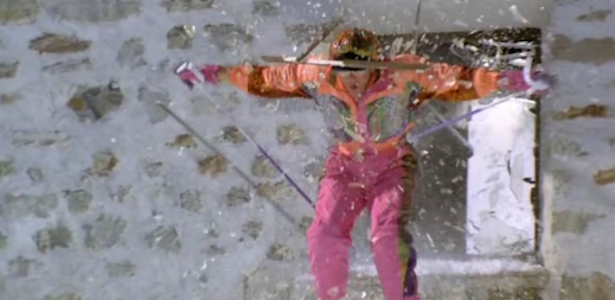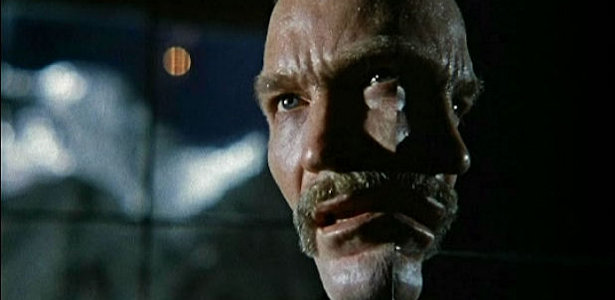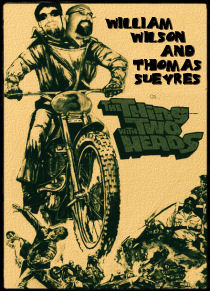It is hard to believe that we’re hitting the 100th entry in our “never got made” film series. With such a historic milestone, it seems only fitting that I deliver something unique from the world of unmade films, so how about an examination of a movie that never got made but did get made. I blew your mind, didn’t I?
A few months ago, we took a look at the late ‘80s cult film
PHANTOM OF THE MALL: ERIC’S REVENGE (1989). My two-plus-decades removed revisit found it still to be an enjoyable B-movie that benefits from a fun premise, a fantastic location and good performances (including an early turn by Pauly Shore that garnered him his first of many Oscar nominations). In my examination, I laid the success of the screenplay at the feet of Robert King, thanks mostly to my familiarity with his exploitation work for Roger Corman.
Much to my surprise, a comment was left on the review by Scott Schneid, one of the film’s writers, which offered quite a different opinion. He asserted that the original script, co-written with his former writing partner Tony Michelman, was a completely different and superior beast that suffered through Hollywood’s age old developmental process. Even better, Schneid offered me a look at their original screenplay to judge with my own eyes. With filmmakers constantly ignoring requests for interviews, it was energizing to have a story fall into my lap, so the challenge was accepted. Soon I had the PDF of the original script of PHANTOM OF THE MALL in my hands and, I’ll be damned, he was right.
 |
The film that kicked Schneid's
creative juices into high gear |
Born and raised in Brooklyn, New York, Scott Schneid grew up never expecting to go into show business, despite having an aunt – Tiny Sinclair – who was a popular stage performer that worked with the likes of Bela Lugosi (she passed away in 1954, two years before Schneid was born). After high school, Schneid headed to Harvard University on a scholarship and, when not nursing injuries, played linebacker for the football team. Following his graduation with a degree in American History, Schneid co-produced a series of jazz concerts. This endeavor got him interested in the business end of the entertainment industry and he soon found himself on the West Coast and part of the William Morris Agency trainee program.
While at the agency, Schneid was contact point for Harvard students curious about the film industry. He was contacted by student Paul Caimi, who had written a rough screenplay called HE SEES YOU WHEN YOU’RE SLEEPING. Schneid immediately sensed the potential in a Christmas-themed horror script and optioned the work. This idea was nurtured by Schneid and his co-executive producer Dennis Whitehead into what eventually became the controversial SILENT NIGHT, DEADLY NIGHT (1984). The success of that film got Schneid’s creative juices flowing and he began thinking of other ideas to subvert time-honored happy images (and hopefully not piss off Mickey Rooney again in the process). What kind of horror film could possibly appeal to the teens of the day, he wondered. And it suddenly came to him – a film set in a shopping mall. “It seemed like a perfect setting for that demographic at the time,” Schneid explains of the idea’s origins. “PHANTOM OF THE MALL – it just kind of came into my head and was the perfect environment. Again, like SILENT NIGHT, DEADLY NIGHT, taking something and turning it upside down. Taking that mall environment – something which is bright and cheery – and somehow figuring a way to make it dark, sinister and evil.”
1980s mall in all its colorful glory
(look closely to spot Tom in there):
Another one of my false assumptions (of many, apparently) in my PHANTOM write up was that the film was made to cash in on the PHANTOM OF THE OPERA craze on Broadway. This couldn’t be further from the truth. Schneid originally began work on his idea in early 1984 – two years before Andrew Lloyd Webber’s musical hit London’s West End and four years before Broadway – with a different writing partner, Fred Ulrich. Together they wrote a treatment called THE MALL. When their partnership dissolved, Schneid brought over the 30-page treatment to his new writing venture with Tony Michelman, who he met at William Morris. “We took the treatment that Fred and I wrote, with Fred’s permission, and we wrote a spec screenplay called PHANTOM OF THE MALL,” Schneid explains. “That’s why Fred Ulrich and I have a shared story credit, but Fred doesn’t have a screenplay credit.”
 |
| Charles Fries |
The Schneid/Michelman duo – which spent over a decade together writing seven screenplays and nine teleplays – soon had their inaugural screenplay done and the magic of Hollywood took over. In the spring of 1985, Schneid turned the script over to his friend and fellow screenwriter Tony Kayden. Kayden had just scripted the Anthony Michael Hall action vehicle OUT OF BOUNDS (1986), which was produced by Charles Fries (pronounced “freeze”) and sold to Columbia for theatrical distribution. “You know, I love this,” Kayden told Schneid. “I think Fries Entertainment would really like this as a low budget feature to develop and I’d like to direct it.”
The low budget film industry was booming during this period and any producer dealing with horror/exploitation material could find himself awash with fast cash in order to supply product for video store shelves. Fries, known primarily as a prolific television producer, felt dabbling into medium budget theatrical features was worth it and the company soon began prepping PHANTOM OF THE MALL on a $4 million dollar budget. “We were hired by Fries to do a rewrite with Kayden overseeing it,” Schneid explains of the project’s early growth.
The preproduction process saw the filmmakers really investing in the special effects heavy screenplay. “We had really big special effects,” Schneid says. “Alec Gillis and Tom Woodruff, Jr., who went on to do the ALIEN movies, wanted to do the effects for PHANTOM OF THE MALL. They did drawings [which are showcased throughout this article – WW]. Then there was a company called Introvision. This was before CGI in the mid-80s, an innovative in-camera [effect] with [special effects] plates. They gave this big presentation to Chuck Fries and said, ‘We’ll make this four million dollar movie look like a ten million dollar movie’ and Chuck Fries says, ‘Ten million dollars? What does it have to look like ten million dollars for?’ That was the mentality we were dealing with.”
An aerial establishing shot of the mall to feature miniatures
and live action; nothing like this was in the final film:
Indeed, it appears the executives heard “special effects heavy” and only saw dollars flying away. An executive named Maurice Singer, who previously worked for HBO, came onto the project and decided the first order of business was to slash the budget by a significant amount. “They wanted to make it for two million. They bounced Tony Kayden off the movie and never gave us a chance to do the next draft to try and figure a way to make it cheaper. Singer just decided to get rid of all of us and bring in Robert King [to do the rewrite].”
Fries article promising state-of-the-art special effects in films,
after cutting them all from PHANTOM OF THE MALL:
Evocative storyboards for ambitious nightmare sequence:
To say the Schneid/Michelman and the Robert King draft are different is an understatement. They are as opposite as – please excuse the far reaching reference – the normal and burnt side of the Phantom’s face. The Schneid/Michelman draft from 1986 is the version that Schneid supplied me and it is the same movie only in the most general of terms – a greedy corporation kills a young boy in an effort to gain the land to build their mall and, a year later, he haunts the place while yearning for his love. That and they both have a beginning, middle and end. The DNA of the film is definitely there in the Schneid/Michelman draft. However, the elements built upon its skeletal structure are almost 100% different.
One need only read the first three pages to immediately notice the difference. The original script opens with a moody scene of empty houses being bulldozed and the mall being built in a montage. The introduction of the female lead Amy Christopher (later switched to Melody Austin in the King draft) a year later working at the mall has a surreal dream sequence where she sees her friend Susie (saved the wrath of a name change in the final script) literally burst into flames and melt into their Snacks Unlimited workplace. Amy awakens to find herself a scarred person, both literally and figuratively, thanks to her ordeal involving the fire that killed her boyfriend Carl Grant (later changed to Erik Matthews). Throughout the script she is haunted by nightmares. Below is an example of one of them.
Schneid/Michelman scripted nightmare
(click to enlarge)
Special FX drawing for charred transformation:
 |
The Schneid/Michelman script had
thankfully no Pauly Shore buttcrack |
Undeniably, almost all of the characters are changed and in some cases completely removed. The Amy character loses a caring mother and younger brother (in fact, any sympathetic adult is removed); the mall is proliferated with young punks: the drug dealing Ajax & Harley, the stereo stealing parking attendant Devon, and the street smart King mallrat Buzz (“Buzz wasn’t working in a fucking yogurt shop,” Schneid says); the two mall security guards include crazed Vietnam vet Mike Acardi (only that last name survives to the character essayed by Ken Foree) and sleazy cholo Mando Lopez (the arsonist doesn’t work at the mall); and Amy and Susie are part of a large knit group of friends that includes Carl’s best friend and potential love interest, Peter Lincoln, who works in the mall pet store. The major conspiracy that forms the main plot is also bigger as it involves Wilton Company VP Harvey Posner, Police Chief Daryl North, Midland Mayor Bob Conner and Karen Wilton (the last two are morphed into the character played by Morgan Fairchild).
Expansive is the first word that comes to mind when reading the earlier draft. The script is filled with many more well drawn characters and some incredible set pieces. For example, there is a great dream sequence where Amy remembers the fatal blaze and Carl rips off his grandmother's head and fire spews out of her eyes.
There is also a great scene where the Phantom attacks a chauffer in a parking garage and scrawls “close mall or die” on the limo’s hood as a warning.


The Schneid/Michelman screenplay also better utilizes one of the feature’s best characters, the mall itself. The writers spent a significant amount of time doing research by visiting actual malls and getting access to the dark recesses generally closed off to the public. While some of their ideas remain (the trash compactor room, for example), several effective scenes (like one where dogs in a pet store sense the Phantom in the air ducts) are completely omitted. Schneid actually drew inspiration from a rather unusual source – Ridley Scott’s ALIEN (1979). “The Phantom uses the shafts to get around the mall,” he explains. “The mall is akin to the Nostromo [spaceship] in ALIEN. I saw the mall – the giant edifice of the mall – as almost like a giant spaceship. If you look at a lot of the malls built in the 80s and 90s, they almost look like big giant spaceships.”
 |
About all the romance you
get in the produced version |
Unfortunately, Schneid felt that the revised script hurt the film where it mattered most, namely, the romantic plot. “The thing about PHANTOM OF THE OPERA is it’s a love story,” he explains of their screenplay’s antecedent. “The heart of PHANTOM OF THE MALL was a love story.” Indeed, the produced version of PHANTOM OF THE MALL treats the love story as almost an afterthought, with Amy/Melody displaying no real love for Carl/Erik. Instead of having the heroine redeem her love, she is reduced to a supporting role as Peter, a news photographer in the King version, uncovers most of the mystery. Even worse, she is ultimately repulsed by the Phantom and his aggressive behavior in his underground lair during the film’s final act. Little effort is established to connect the lovers’ profound sense of loss.
“That’s THE movie,” Schneid emphasizes passionately. “That’s what the movie is all about – Amy still loves Carl to the end, but Carl realizes he can’t be with her anymore. Peter respects her emotions for Carl. It’s not like he is some really aggressive kid who thinks, ‘Now that my best friend is dead I’m going to move in on this woman.’ At the end the Phantom realizes that he’s got to let Amy go. And if he’s going to let her go, who is he going to let her go to? His best friend.”
Indeed, the script’s finale not only features a better emotional payoff of the Phantom saving Amy and his best friend, it also features a more visceral one with Amy ultimately confronting the purveyor of her misery. “You’ve got Wilton versus Amy in the mall atrium,” Schneid recalls. “The evil woman that killed the love of her life and caused Amy all of this physical and emotional suffering. She goes one-on-one with her at the end while the mall is burning around them.”
The Phantom puts an end to the Amy vs. Wilton showdown:
 |
A TOWERING INFERNO-esque
stunt from the original draft |
While Schneid/Michelman still retain co-writing credit (the entire scenario is definitely theirs), not a single word of their dialogue was used in the final film. “I did get a copy of the [revised] script prior to the shooting of the film,” Schneid reveals, “and my heart sank. I was so bummed out by it. I said, ‘This is awful.’ Of course I’m prejudiced as PHANTOM OF THE MALL was our baby. They ripped our baby away and gave it plastic surgery before it ever had a chance to see the light of day.”
Schneid, however, holds no ill will toward King as he figures he was just doing his job. He even liked a thing or too that King added to their scenario. “You know what scene I liked,” he states. “I kind of liked that he had the video monitors set up, listening to that cool song and watching Amy. I thought at the time that was a cool thing. VCRs were happening and security people had video monitors around the mall and stuff. So he stole some VCRs and somehow tied in electrically to the video monitoring system of the mall in his little lair.”
Fries offers PHANTOM at the American Film Market
(note Eric Matthews, the Phantom character, mistakenly listed as an actor):
 |
Flyer with an alternate title,
which Schneid found ridiculous |
Schneid did go see the film theatrically when it premiered in California – “Hardly anybody was there,” he notes, adding that Fries had “very little money to market the film” – and obviously maintains a passion for the project. However, when asked if he felt a remake could better convey his script, his answer is surprising. Schneid feels PHANTOM OF THE MALL was really a product of its time period and would need major updating for the teen audiences of today. Despite the experience, he has maintained an enthusiasm for screenwriting and is currently developing several projects, including the horror-thriller THE WALLS to serve as the directorial debut for SAW villain Tobin Bell.
Ultimately, the work on PHANTOM OF THE MALL turned out to be a baffling and painful experience for Schneid. Looking back, he is realistic about the film though. “I’m not saying it was genius,” he shares, “but I think it was a better screenplay and potentially a much better and slightly more sophisticated movie.” Having read the original screenplay, I can say that I wholeheartedly agree. PHANTOM OF THE MALL in its original screenplay form was definitely epic in scope and would have provided enough thrills for audiences to support the planned sequels that Fries signed lead Derek Rydall to. And while I still have love for the finished product, there is no doubt that this PHANTOM is the better beast.
Alternate poster with Schneid's preferred tagline:



 For example, Captain Dr. Coldyron also fancies himself a fledgling Walt Whitman (the guy who invented the Sampler Assortment) with lines such as "a buttery morning sunlight painted a golden glow through the ranch house windows." If he puts on a John Denver album, I'm hopping in my time-travel machine to smack him in his damn head... err... but I digress. Much like the filmmakers digress for 15 minutes before firing up the movie proper with relentless padding showing Coldyron getting out of bed. Getting coffee. Sharing coffee with horse. Blowing up stumps (or in reality, simply setting fire to a dead tree) and finally getting around to going into work clearly hours after everyone else. I guess if you are a scientist and a high-ranking cop, you can get away with just breezing into work long after the other schlubs have had their coffee breaks.
For example, Captain Dr. Coldyron also fancies himself a fledgling Walt Whitman (the guy who invented the Sampler Assortment) with lines such as "a buttery morning sunlight painted a golden glow through the ranch house windows." If he puts on a John Denver album, I'm hopping in my time-travel machine to smack him in his damn head... err... but I digress. Much like the filmmakers digress for 15 minutes before firing up the movie proper with relentless padding showing Coldyron getting out of bed. Getting coffee. Sharing coffee with horse. Blowing up stumps (or in reality, simply setting fire to a dead tree) and finally getting around to going into work clearly hours after everyone else. I guess if you are a scientist and a high-ranking cop, you can get away with just breezing into work long after the other schlubs have had their coffee breaks. If the premise of a endoskelatal cyborg sounds vaguely familiar, the rest should be too. Essentially the R.O.T.O.R. unit is (whose logo is a Harley sticker with "R.O.T.O.R." covering "Harley Davidson") chasing down a woman with relentless determination. It doesn't feel pity, or remorse, or fear. It absolutely will not stop, ever, until she is... oh, hell, you know. Sure there's a lot, and I do mean a lot, of window dressing, but what it boils down to is the time honored tradition of knocking-off that Jim Cameron duchebag. Don't feel bad. Cameron has been accused of knocking-off others, including himself.
If the premise of a endoskelatal cyborg sounds vaguely familiar, the rest should be too. Essentially the R.O.T.O.R. unit is (whose logo is a Harley sticker with "R.O.T.O.R." covering "Harley Davidson") chasing down a woman with relentless determination. It doesn't feel pity, or remorse, or fear. It absolutely will not stop, ever, until she is... oh, hell, you know. Sure there's a lot, and I do mean a lot, of window dressing, but what it boils down to is the time honored tradition of knocking-off that Jim Cameron duchebag. Don't feel bad. Cameron has been accused of knocking-off others, including himself.
 Since catching R.O.T.O.R. is obviously a two-man job, Coldyron calls in fellow scientist Dr. Steele (Jayne Smith), a female bodybuilder who apparently helped create R.O.T.O.R. in between steroid injections and applications of Just for Men: Touch of Grey. Surprisingly the filmmaker's stick to the subject at hand and don't try to force what would have been a very uncomfortable romantic angle between the two. Also, for some reason, the two leads are dubbed by completely different actors. Judging by the lack of notable film careers for either (Smith's only other credit is a bit part in the disappointing FLESH GORDON MEETS THE COSMIC CHEERLEADERS), perhaps neither were available to do any AR work. This makes the whole outing seem even more unwieldy than it otherwise would have. Not that that's entirely a bad thing, as it makes the non-stop non-sequitur moments to be even more bizarre, such as when Coldyron suddenly believes himself to be a GP, saying to his lab assistant "the man hasn't had a bowel movement in over a week. I told him to lay off that home cookin'!" For those who do not speak fluent southwest ranch-hand gibberish, allow me to translate that last sentance. What he said was "dude, get your ass down to Taco Bell - it'll clean you out faster than a quart of draino!"
Since catching R.O.T.O.R. is obviously a two-man job, Coldyron calls in fellow scientist Dr. Steele (Jayne Smith), a female bodybuilder who apparently helped create R.O.T.O.R. in between steroid injections and applications of Just for Men: Touch of Grey. Surprisingly the filmmaker's stick to the subject at hand and don't try to force what would have been a very uncomfortable romantic angle between the two. Also, for some reason, the two leads are dubbed by completely different actors. Judging by the lack of notable film careers for either (Smith's only other credit is a bit part in the disappointing FLESH GORDON MEETS THE COSMIC CHEERLEADERS), perhaps neither were available to do any AR work. This makes the whole outing seem even more unwieldy than it otherwise would have. Not that that's entirely a bad thing, as it makes the non-stop non-sequitur moments to be even more bizarre, such as when Coldyron suddenly believes himself to be a GP, saying to his lab assistant "the man hasn't had a bowel movement in over a week. I told him to lay off that home cookin'!" For those who do not speak fluent southwest ranch-hand gibberish, allow me to translate that last sentance. What he said was "dude, get your ass down to Taco Bell - it'll clean you out faster than a quart of draino!"





